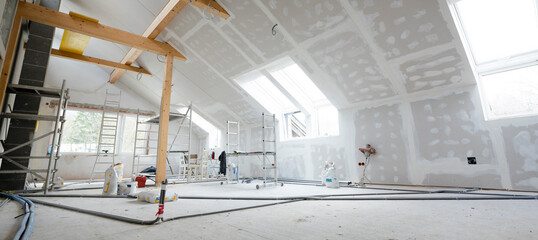Drywall is a cornerstone of modern construction, forming the walls and ceilings that define our living and working spaces. Its versatility, durability, and cost-effectiveness make it an essential material for both residential and commercial projects. Understanding the basics of drywall, from installation to maintenance, helps property owners, builders, and renovators make informed decisions and achieve high-quality results.

What Drywall Is and Why It Matters
Drywall, also known as gypsum board or plasterboard, consists of a layer of gypsum sandwiched between two sheets of heavy paper. It serves as a structural and finishing material, providing smooth surfaces for painting, wallpapering, or other finishes. Unlike traditional plaster, drywall is quicker to install, easier to repair, and more consistent in appearance.
Its benefits go beyond aesthetics. Drywall also contributes to soundproofing, fire resistance, and energy efficiency. When properly installed, it creates walls that are strong, smooth, and ready for any type of finishing.
Types of Drywall
Several types of drywall exist to meet different project needs:
- Standard drywall is suitable for most interior walls and ceilings.
- Moisture-resistant drywall is ideal for bathrooms, kitchens, and basements, where damp conditions could cause mold or damage.
- Fire-resistant drywall provides additional safety in areas where building codes require it.
- Soundproof drywall incorporates special materials to reduce noise transmission between rooms.
Choosing the right type of drywall ensures durability, compliance with building codes, and suitability for the intended environment.
Drywall Installation Process
Proper installation is key to achieving smooth, durable walls. The process typically involves several steps:
- Measuring and Cutting – Sheets are measured and cut to fit walls or ceilings precisely.
- Hanging – Panels are fastened to wall studs or ceiling joists using screws or nails. Proper alignment ensures stability and a uniform surface.
- Taping and Mudding – Joints between panels are covered with tape and joint compound to create a seamless finish. Multiple layers may be applied for smoothness.
- Sanding – Once the compound dries, surfaces are sanded to remove imperfections, creating a flawless finish.
- Finishing – The drywall is now ready for painting, wallpaper, or other decorative treatments.
Attention to detail at every step prevents cracks, uneven surfaces, or weak spots, ensuring the final walls are strong and visually appealing.
Benefits of Professional Installation
While some DIY enthusiasts may attempt drywall installation, professional services offer clear advantages. Skilled installers work efficiently, accurately, and safely. They know how to handle large sheets, make precise cuts, and apply joint compound evenly.
Professional installation also reduces the likelihood of common problems, such as:
- Uneven seams and ridges
- Nail pops or screw holes
- Cracks or sagging panels
- Poor alignment at corners and edges
By hiring experts, property owners can achieve a polished, long-lasting result without the trial-and-error that often comes with DIY projects.
Drywall Maintenance and Repair
Drywall is durable, but it is not impervious to damage. Common issues include holes from nails or accidents, cracks from settling, or water damage from leaks. Regular maintenance and prompt repairs extend the life of your walls and prevent more serious problems.
- Small holes and dents can be patched with a simple compound and sanded smooth.
- Cracks along seams or corners may require re-taping and mudding.
- Water-damaged sections often need replacement to prevent mold growth.
Routine inspections, especially after renovations or extreme weather events, help identify and address damage early.
Drywall and Energy Efficiency
Drywall contributes to energy efficiency by providing an additional layer of insulation. Modern construction often incorporates thicker or insulated drywall, which helps regulate indoor temperatures and reduces heating and cooling costs. Combined with proper sealing of seams and joints, drywall plays a role in creating a more energy-efficient home or office.
Soundproofing and Comfort
In multi-family buildings, offices, or home theaters, sound control is a priority. Drywall, especially specialized soundproof panels, helps reduce noise transmission between rooms. Combined with insulation, resilient channels, or double layers of drywall, it creates quieter, more comfortable spaces.
Safety Considerations
Certain types of drywall enhance safety in specific areas. Fire-resistant drywall is commonly used in kitchens, utility rooms, or near furnaces and fireplaces. It slows the spread of flames and complies with building safety codes, providing additional peace of mind.
Proper handling during installation is also important. While drywall is generally safe, cutting and sanding produce dust that can irritate skin, eyes, and lungs. Professionals wear protective equipment and use dust-control techniques to maintain a safe work environment.
Design Versatility
Drywall is not just a functional material; it is also highly versatile in design. It can be shaped into curves, arches, and custom ceilings, allowing for creative architectural features. With proper finishing, it provides a smooth canvas for painting, wallpaper, or decorative textures, helping homeowners and designers achieve their vision.
Planning for Drywall Projects
Successful drywall projects start with careful planning. Considerations include:
- Type of drywall suited for the space
- Dimensions and layout of walls and ceilings
- Location of electrical outlets, switches, and plumbing
- Finishing preferences, such as paint or textures
- Budget and timeline for installation or renovation
Good planning ensures that drywall meets both functional and aesthetic goals while staying on schedule and within budget.
Drywall is a fundamental component of modern construction, offering durability, design flexibility, and functional benefits like soundproofing, fire resistance, and energy efficiency. Proper installation and maintenance are essential to maximize these advantages.
By understanding the types of drywall, the installation process, and the importance of professional services, property owners and builders can create strong, smooth, and visually appealing walls that stand the test of time. With timely maintenance and careful planning, drywall transforms a structure into a comfortable, safe, and inviting space for years to come.